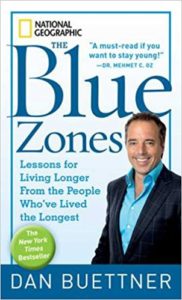Learn how to live a long, healthy life

Foreword by Karl: Did you ever feel discouraged about the apparently contradictory information about nutritional science out there? The media seems to catch every opportunity to make yet another sensational headline with diets like the Paleo diet, the Ketogenic diet, low carb diets, high carb low-fat diets, high protein diets… how can we make sense out of all this contradiction? If you are like me, it will take you a good amount of research to finally see “the light.” I read many books and fell in some fad diets before I started to understand why there seems to be a contradiction. But I won’t focus on nutritional science in this post, in this post we’ll take a different approach. How about just doing the obvious? Looking at our beautiful planet and to see where do people actually live the longest and what they eat? That’s what the book The Blue Zones is all about.
The world is full of different cultures and civilizations with their unique habits and ways of living. In some cultures, people seem to live longer and healthier lives. One of those Blue Zones is the Italian island of Sardinia. Research from 2011 found that on average one in 600 people in Sardinia live to an age of 100 instead of one in 4000 people in the United States.
So is it the genes? Aren’t people in Sardinia just blessed with genes with more longevity? The answer is no. The biggest factor of longevity is our lifestyle, not our genes. A Danish study on over 2500 twins found that out of all factors contributing to our lifespan, genes account only about 25%.
It turns out that the aging process can be accelerated or slowed down depending on the lifestyle we choose. And people in the Blue Zones can teach us a lot about a healthy lifestyle.
Food, the key to longevity
Most Blue Zones have a thing in common, their diets are predominantly based on plants. Meat and other animal products are either the exception or used as a condiment, not the main dish.
In Japans Blue Zone of Okinawa, there is a special philosophy regarding food: They only eat until they are 80% full. This slows the metabolism and reduces the damage of oxidants in the body.
Drinking plenty of water is another trait common in blue zones like Loma Linda, a settlement of the Seventh Day Adventists outside Los Angeles. Instead of other beverages, the Adventists drink five to six glasses of water a day.
Wine is usually consumed with the daily meals in the Blue Zone Island of Sardinia which boasts a high life expectancy for men. Wine contains flavonoids which have many benefits like reducing the risk of certain cancers and heart disease, they can also be found in dark chocolate and brightly colored fruits and vegetables.
Family and purpose
In all Blue Zones, the family plays a special role. If elders are expected to provide help and if they put family first, it gives a clear purpose for them. And a purpose is an important driving force for a long and satisfying life. More Americans die in the first year of retirement than in the last year of work which suggests that work can provide a meaningful purpose. But why relying on work if there are many other ways to create a purpose?
In the Costa Rican Blue Zone of the Nicoya peninsula, everyone feels like they have a plan de vida, a life plan. Even at ages above 60 and 70 inhabitants of Nicoya don’t stop living. They keep themselves busy, they love to work because it provides fruit for their families and their families are their core purpose.
Community and spirituality
Similar to families, a community creates a sense of belonging and purpose. In Okinawa, the sense of community is called Moai. Moai originated from meetings of common porposes like harvest and the arrangement of local festivities. Today it’s a vehicle of companionship and provides a purpose for the Okinawans.
The Okinawans also put emphasis on spirituality, spirituality for them means living in the moment and leaving the past untouched. The past is viewed as necessary to enjoy the present. Spirituality can also include physical activities like in the case of the Seventh Day Adventists of Loma Linda. As part of keeping their Sabbath, they get physical exercise and meet friends, family and community members.
Stress reduction, physical activity, and Sun exposure
All Blue Zones use methods to reduce stress. In Sardinia, people keep a good sense of humor. They don’t take themselves too seriously and can laugh at their own expense.
In Loma Linda, the Sabbath represents an opportunity to find time for others and have fun. Sex and physical activity is another great stress reducer. In the Costa Rican Blue Zone people have very liberal attitudes towards sex which makes them more relaxed and keeps stress down.
In Sardinia, most centenarians are or were shepherds and shepherds walk about six miles per day which are very healthy. People from Loma Linda undertake different types of physical activity throughout the day like walking, swimming, and hiking.
All the outdoor activity comes with another great benefit, increased sun exposure which assures sufficient Vitamin D. Vitamin D plays an important role in health and wellbeing.
